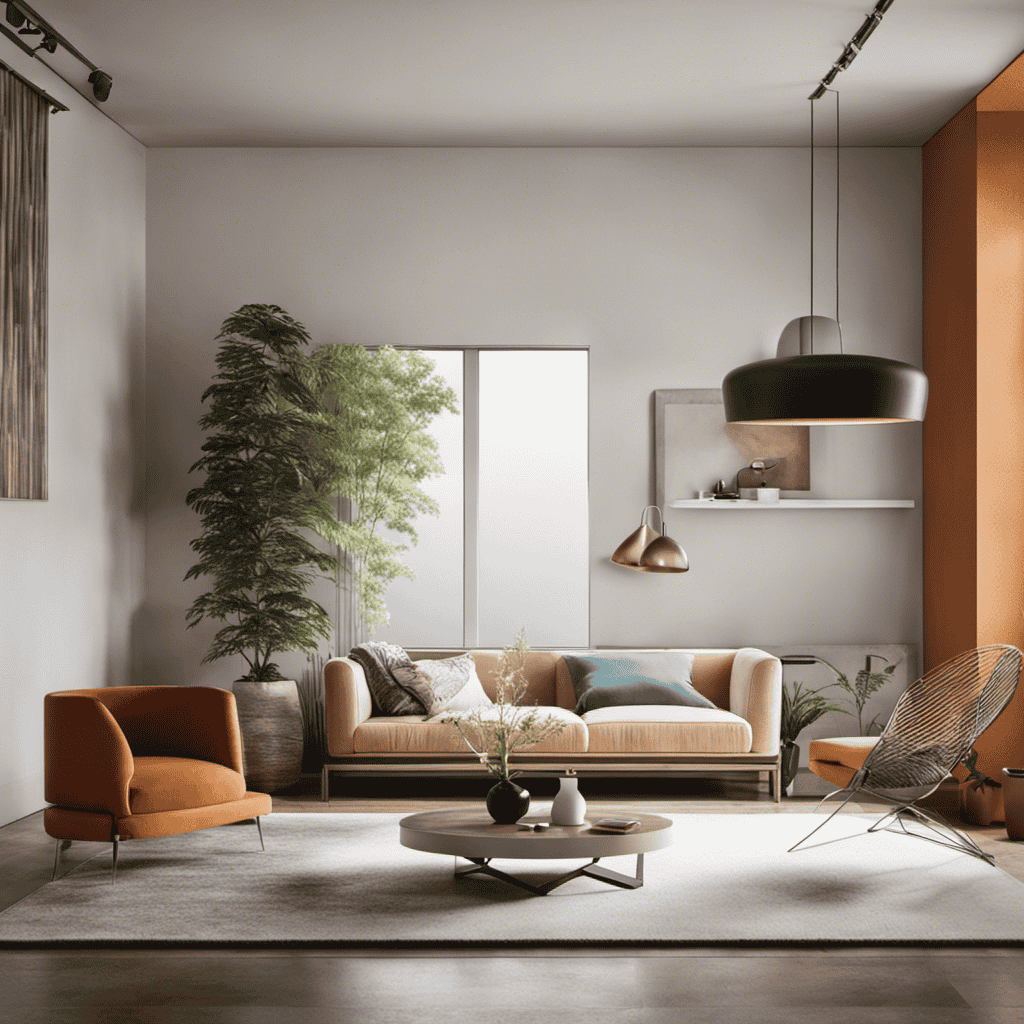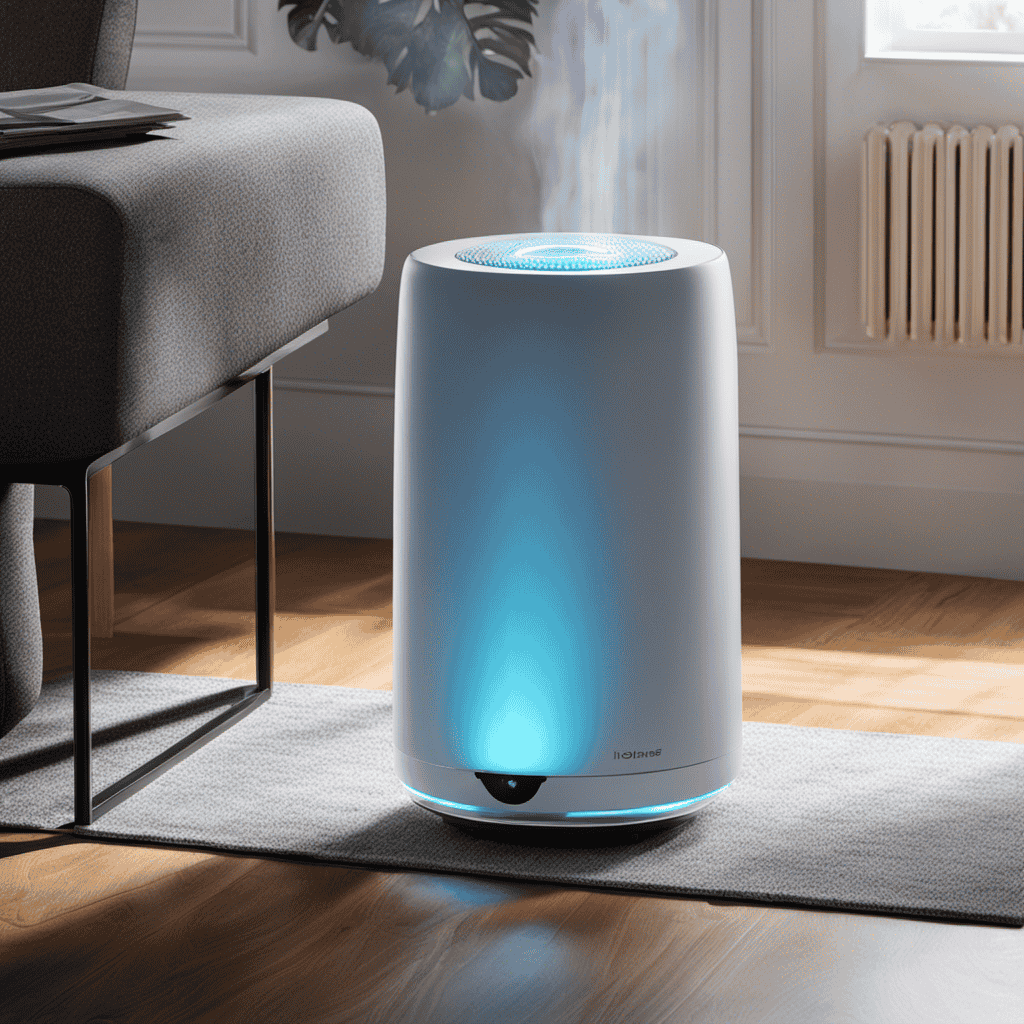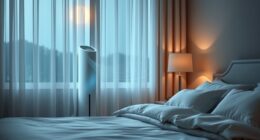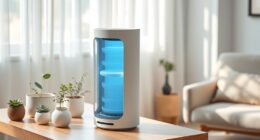I’ve always been curious about why the red light on my Honeywell air purifier keeps coming on. It’s frustrating not understanding its significance or how to resolve it. If you’re seeking answers like me, you’ve come to the right spot.
In this article, we’ll explore the common reasons behind the red light on your Honeywell air purifier, how to understand the indicator lights, troubleshoot the issue, and ultimately, fix it.
Let’s dive in and shed some light on this problem.
Key Takeaways
- The red light on a Honeywell Air Purifier indicates a filter issue or power issue.
- Regular maintenance is crucial for optimal performance and to prevent the red light from coming on.
- Clean indoor air reduces the risk of respiratory issues and improves overall health and well-being.
- Cleaning the carbon filter every 6 months is recommended to maintain clean indoor air and ensure the effectiveness of the air purifier.
Common Reasons for a Red Light on a Honeywell Air Purifier
One common reason for the red light on your Honeywell air purifier is a dirty or clogged filter. Understanding the red light indicators and troubleshooting red light errors can help resolve the issue.
When the filter becomes clogged with dirt, dust, and other particles, it restricts airflow and reduces the purifier’s efficiency. As a result, the red light illuminates to alert you about the problem. To fix this issue, you need to clean or replace the filter.
Start by turning off the air purifier and unplugging it from the power source. Open the purifier’s front panel and locate the filter. Remove the filter and either vacuum or rinse it, depending on the type. If it’s a washable filter, allow it to dry completely before reinserting it. If the filter is non-washable or damaged, replace it with a new one.
Once the filter is clean or replaced, close the front panel, plug in the air purifier, and turn it on. The red light should disappear, indicating that the filter issue is resolved.
Understanding the Indicator Lights on Your Honeywell Air Purifier
To understand the indicator lights on your Honeywell air purifier, you should refer to the user manual. However, I can provide you with a brief overview to help you troubleshoot any issues you may encounter. Here are four key things to know about the indicator lights on your Honeywell air purifier:
-
Power Light: This indicates whether the unit is turned on or off. A solid green light means the purifier is operating properly, while a solid red light indicates a power issue.
-
Filter Light: This light reminds you to check and replace the filters when necessary. A solid red light means it’s time to replace the filters.
-
Timer Light: If your air purifier has a timer function, this light will indicate whether it is currently activated or not.
-
Ionizer Light: Some Honeywell air purifiers have an ionizer function. This light indicates whether the ionizer is turned on or off.
Understanding these indicator lights will help you maintain your air purifier effectively. Now, let’s dive into troubleshooting the red light issue on your Honeywell air purifier.
Troubleshooting the Red Light Issue on Your Honeywell Air Purifier
If you’re experiencing a solid red indicator, it’s likely indicating a power issue with your Honeywell air purifier.
To troubleshoot this problem, there are a few steps you can take.
First, check if the power cord is securely plugged into an outlet. If it is, try plugging another device into the same outlet to ensure it’s working properly.
If the outlet is functioning correctly, the next step is to check the power switch on the air purifier. Make sure it’s in the ‘on’ position and not in the ‘off’ or ‘standby’ mode.
If none of these steps resolve the issue, it may be necessary to contact Honeywell customer support for further assistance.
Remember to regularly clean and maintain your air purifier to prevent any future power issues.
How to Fix a Red Light on Your Honeywell Air Purifier
Check if the indicator is solid and not blinking on your Honeywell air purifier. If the red light is on, it could indicate a problem that needs to be addressed. Here are some troubleshooting steps to help you fix the issue:
-
Reset the air purifier: Unplug the unit from the power source and wait for about 10 seconds before plugging it back in. This can often resolve minor glitches.
-
Check the filter: Make sure the filter is clean and properly installed. A dirty or incorrectly placed filter can trigger a red light.
-
Verify the settings: Ensure that the air purifier is set to the desired mode and fan speed. Incorrect settings may cause the red light to appear.
-
Contact customer support: If none of the above steps work, it is recommended to reach out to Honeywell customer support for further assistance in troubleshooting your air purifier.
Remember to always refer to your Honeywell air purifier’s user manual for specific instructions on how to reset and troubleshoot your device.
The Importance of Addressing a Red Light on Your Honeywell Air Purifier
Addressing the issue promptly is important as it could indicate a problem with your Honeywell air purifier. Regular maintenance is crucial for the optimal performance of your air purifier.
Many people have misconceptions about air purifiers and believe that once they purchase one, it will work flawlessly without any maintenance. However, this is not the case. Air purifiers, including Honeywell models, require regular cleaning and filter replacements to ensure their efficiency and effectiveness.
Neglecting maintenance can lead to a variety of issues, including a red light indicator. The red light could indicate a clogged filter or a malfunctioning sensor.
Possible Causes Behind the Red Light on Your Honeywell Air Purifier
To troubleshoot the issue, you can start by cleaning the filters of your Honeywell air purifier. Here are possible causes behind the red light on your Honeywell air purifier:
-
Dirty Filters: Over time, the filters in your air purifier can become clogged with dust and pollutants, reducing their effectiveness. Regularly cleaning or replacing the filters can restore optimal performance.
-
Filters Replacement: If the red light persists even after cleaning the filters, it may be time to replace them. Honeywell recommends replacing the filters every 3-6 months for optimal air purification.
-
Sensor Malfunction: The red light could indicate a sensor malfunction. Try resetting the air purifier or contacting Honeywell customer support for assistance.
-
Air Quality Monitoring: Some Honeywell air purifiers have built-in air quality sensors. The red light may indicate poor air quality. Ensure the air purifier is placed in a suitable location away from potential sources of pollution.
Tips for Preventing the Red Light From Coming on On Your Honeywell Air Purifier
One way to prevent the red light from coming on is by regularly cleaning or replacing the filters in your Honeywell air purifier. Filters play a crucial role in improving indoor air quality and preventing allergies. Dust, pollen, pet dander, and other airborne particles can accumulate in the filters over time, causing them to become clogged and less effective. By cleaning or replacing the filters, you ensure that your air purifier continues to operate efficiently and effectively. Here’s a simple guide to help you with filter maintenance:
| Maintenance Tips | Frequency |
|---|---|
| Clean the pre-filter | Every 3 months |
| Replace the HEPA filter | Every 12-18 months |
| Clean the carbon filter | Every 6 months |
Following these maintenance tips will help you maintain clean indoor air, reduce allergens, and prevent the red light from coming on.
Frequently Asked Questions
Can I Use My Honeywell Air Purifier Without Fixing the Red Light Issue?
No, it is not recommended to use the Honeywell air purifier without fixing the red light issue. Troubleshooting the red light is important to ensure the proper functioning and effectiveness of the purifier.
Will the Red Light on My Honeywell Air Purifier Go Away on Its Own?
The red light on my Honeywell air purifier indicates a problem that needs attention. It could indicate a filter replacement or a malfunction. Ignoring it may damage the purifier. It won’t go away on its own.
Can a Power Outage Cause the Red Light on My Honeywell Air Purifier?
Yes, a power outage can potentially damage or affect a Honeywell air purifier. It is important to ensure that the device is properly protected and to follow manufacturer guidelines to prevent any issues.
Will Using a Different Filter Solve the Red Light Issue on My Honeywell Air Purifier?
Using a different filter may solve the red light issue on your Honeywell air purifier. It can provide benefits such as improved air quality and reduced allergens. Troubleshooting the red light can help ensure optimal performance.
How Often Should I Clean the Exterior of My Honeywell Air Purifier to Prevent the Red Light From Coming On?
To prevent the red light from coming on, I should clean the exterior of my Honeywell air purifier regularly. It is safe to use even if the light is on, but I should also replace the filter as recommended.
Conclusion
In conclusion, it is clear that addressing the red light issue on a Honeywell Air Purifier is crucial for optimal performance. By understanding the indicator lights and following the recommended steps to fix the red light, users can ensure their air purifier is functioning effectively.
Additionally, implementing preventive measures can help avoid future red light occurrences. It is important to prioritize the maintenance and care of your Honeywell Air Purifier to enjoy clean and fresh air in your surroundings.










